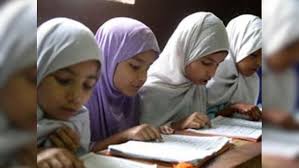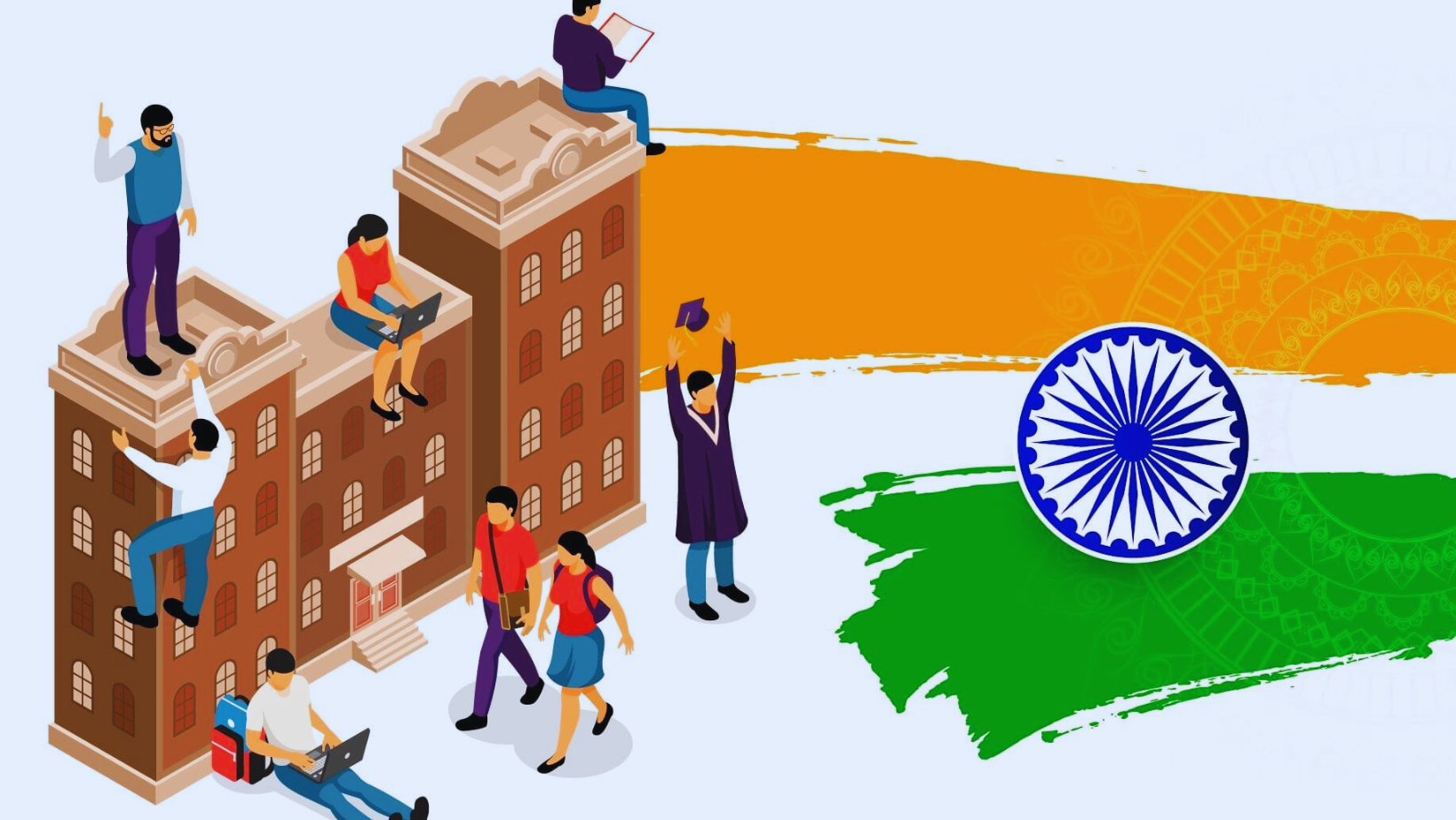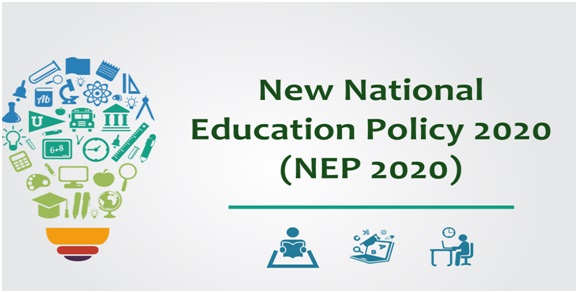Unified District Information System for Education Plus (UDISE+) Report

- 10 Jan 2025
In News:
The Unified District Information System for Education Plus (UDISE+) report for 2023-24 reveals a significant decline in school enrolment across India, highlighting critical challenges in the education sector. The total enrolment in grades 1-12 fell by over 1.55 crore students, from 26.36 crore (2018-2022 average) to 24.8 crore in 2023-24. This represents a 6% drop, with the biggest declines occurring in government schools.
Key Findings:
- Enrolment Decline:
- In 2023-24, enrolment decreased from 25.17 crore in 2022-23 to 24.8 crore.
- The drop was not only in government schools (5.59%) but also in private schools (3.67%).
- States like Bihar, Uttar Pradesh, and Maharashtra saw the largest decreases.
- The decline in enrolment is despite an increase in the number of schools, from 14.66 lakh in 2022 to 14.72 lakh in 2023.
- Methodology Change:
- A significant change in the data collection methodology occurred in 2022-23, including linking enrolment to Aadhaar numbers, aimed at reducing data duplication.
- While this has improved data accuracy, it has also led to the removal of inflated figures, explaining part of the enrolment drop.
- Despite these changes, there has been a notable decline of 37 lakh students from 2022-23 to 2023-24, which remains unexplained in the report.
- Gender and Age Trends:
- Boys’ enrolment declined by 6.04%, and girls’ by 5.76%, reflecting a uniform drop across gender groups.
- The dropout rates increase as students progress through school, with the highest dropout at the secondary level.
- Infrastructure and Facilities:
- While most schools have basic facilities like electricity and gender-specific toilets, advanced infrastructure like functional computers (57%) and internet access (53%) is lacking in nearly half of schools.
- This technological gap exacerbates regional disparities and affects educational quality, particularly in rural areas.
- State-Specific Impact:
- Jammu and Kashmir, Assam, Uttar Pradesh, and Madhya Pradesh saw the highest reductions in the number of schools.
- Many school closures or mergers have led to increased distances for students, causing further dropouts during re-admission processes.
Socio-Economic Barriers:
- Economic hardships, migration, and inadequate facilities contribute to the enrolment decline.
- Low-income families and backward regions struggle to prioritize education, further affecting enrolment and retention.
Government Initiatives:
- Initiatives like the National Education Policy (NEP) 2020, Sarva Shiksha Abhiyan, and Right to Education Act (RTE) have made strides in primary education but face challenges in secondary education.
- Education spending has hovered around 4-4.6% of GDP, which is insufficient to meet the needs of the education system.
Moving Forward:
- Targeted Interventions: Focus on expanding vocational training, incentivizing school attendance, and improving digital infrastructure in schools.
- Address Regional Disparities: Conduct audits to address school shortages in densely populated areas and consolidate underutilized urban schools.
- Enhancing Teacher Quality: Invest in teacher training and encourage innovative teaching methods.
- Community Engagement: Promote local participation in school management to address specific educational needs.
Conclusion:
The UDISE+ 2023-24 report underscores the need for urgent reforms in India's education system, focusing on increasing enrolment, reducing dropout rates, and ensuring equitable access to quality education. By addressing these challenges with targeted policies, India can move closer to achieving its educational goals.
Unified District Information System for Education Plus (UDISE+) 2023-24 Report
- 04 Jan 2025
In News:
The UDISE+ report for 2023-24, released by the Ministry of Education, presents key insights into India’s school education system. UDISE+ serves as a comprehensive database, tracking student enrolment, school infrastructure, and other educational parameters, enabling efficient policy implementation and gap identification.
Key Findings:
- Decline in School Enrolment: Enrolment figures in Indian schools have witnessed a significant decline for the first time in recent years. The total enrolment dropped from 26.36 crore (2018-22 average) to 25.17 crore in 2022-23 and further to 24.8 crore in 2023-24, marking a fall of 1.55 crore students or nearly 6%. This drop is attributed to the improved data collection methods which helped eliminate duplicate entries, especially students enrolled in both government and private schools.
- Gender and School Type-wise Trends: The enrolment drop was observed across both government and private schools. Government schools saw a decline of 5.59%, whereas private schools experienced a 3.67% reduction. Gender-wise, the enrolment of boys decreased by 6.04%, while girls’ enrolment dropped by 5.76%, compared to the 2018-22 average.
- State-wise Data: The enrolment drop was not uniform across states. Bihar recorded the largest decline, with a loss of 35.65 lakh students, followed by Uttar Pradesh (28.26 lakh) and Maharashtra (18.55 lakh). In contrast, states like Andhra Pradesh, Delhi, Jammu & Kashmir, and Telangana saw an increase in enrolment during the same period.
- Level-wise Trends: The most significant declines were recorded at the primary (Classes 1-5), upper primary (Classes 6-8), and secondary (Classes 9-10) levels. However, enrolment in pre-primary and higher secondary (Classes 11-12) levels showed an increase in 2023-24 compared to the previous average.
- Impact of Data Refinement: The implementation of Aadhaar-linked student data collection has enhanced the accuracy of enrolment figures. The de-duplication process helped remove cases of students being enrolled in both government and private schools. This revision is expected to provide more accurate data for targeted educational schemes and improve the effectiveness of government programs like Samagra Shiksha and PM POSHAN.
Challenges in Education
Despite the improvements in data collection, several systemic issues persist:
- Access and Retention: High dropout rates, especially at the secondary level, remain a challenge for sustained student retention.
- Disparities among Marginalized Groups: Enrolment among SC, ST, OBC, and minority communities showed a notable decline, reflecting existing inequities in the education system.
- Infrastructure and Teacher Training: Uneven distribution of resources and insufficient teacher training continue to hamper educational outcomes, affecting quality and student engagement.
Way Forward
To address these challenges, the following steps are critical:
- Strengthening NEP 2020: The National Education Policy aims for universal Gross Enrolment Ratio (GER) by 2030, with a focus on skill-based learning and inclusive education.
- Teacher Capacity Building: There is a need for targeted interventions to improve teacher quality and address gaps in the student-teacher ratio.
- Infrastructure Optimization: Schools should optimize their resources based on enrolment trends to improve access and address disparities.
- Data-Driven Monitoring: Continuous monitoring using student-specific data will help identify dropouts and allocate resources efficiently.
Uttar Pradesh Board of Madarsa Education Act, 2004

- 09 Nov 2024
In News:
The Supreme Court recently upheld the constitutional validity of the Uttar Pradesh Board of Madarsa Education Act, 2004 (also called the Madarsa Act), while striking down certain provisions related to the granting of higher education degrees. The Court overturned the Allahabad High Court's previous decision, which had deemed the Act unconstitutional on the grounds that it violated the principle of secularism.
What is the Madarsa Act?
The Madarsa Act provides a legal framework for regulating madrasas (Islamic educational institutions) in Uttar Pradesh. The Act:
- Establishes the Uttar Pradesh Board of Madarsa Education, which oversees the curriculum and examinations for madrasas.
- Ensures that madrasas follow the National Council of Educational Research and Training (NCERT) curriculum for mainstream secular education alongside religious instruction.
- Empowers the state government to create rules for regulating madrasa education.
Allahabad High Court's Ruling
In March 2024, the Allahabad High Court declared the Madarsa Act unconstitutional, citing:
- Violation of secularism: The Court argued that the Act's emphasis on compulsory Islamic education, with modern subjects being optional, discriminated on religious grounds, violating the secular nature of the Constitution.
- Right to Education: The Court also claimed that the Act denied quality education under Article 21A, which guarantees free and compulsory education to children.
- Higher Education Degrees: The Act's provisions allowing the granting of Fazil and Kamil degrees were found to conflict with the University Grants Commission Act, 1956, which regulates higher education.
Supreme Court's Ruling
The Supreme Court overturned the Allahabad High Court's decision on several grounds:
- Basic Structure Doctrine: The Court clarified that the basic structure doctrine, which applies to constitutional amendments, does not apply to ordinary legislation like the Madarsa Act. Therefore, a law cannot be struck down simply for violating secularism unless explicitly prohibited by the Constitution.
- State's Authority to Regulate Education: The Court held that the state has the right to regulate education in minority institutions, as long as the regulation is reasonable and rational. It emphasized that the Madarsa Act does not deprive these institutions of their minority character.
- Right to Education for Minority Institutions: Referring to a 2014 decision, the Court ruled that the Right to Education Act (RTE) does not apply to minority institutions, as it would undermine their right to impart religious education and self-administer.
Striking Down Higher Education Provisions
While upholding most of the Act, the Supreme Court struck down the provisions related to higher education degrees (Fazil and Kamil). It ruled that:
- Section 9 of the Act, which allowed the Board to grant these degrees, is in conflict with the University Grants Commission Act, which only permits degrees to be awarded by universities recognized by the UGC.
Implications of the Ruling
- Regulation of Madrasa Education: The ruling affirms the state's authority to ensure quality education in madrasas, balancing religious instruction with secular subjects.
- Protection of Minority Rights: By upholding the Madarsa Act, the Court protected the rights of religious minorities to run educational institutions while ensuring they meet educational standards.
- Focus on Inclusivity: The judgment emphasizes the integration of madrasas within the broader educational framework, ensuring that madrasa students receive quality education.
In conclusion, the Supreme Court's decision supports the regulation of madrasa education while safeguarding the rights of minority institutions, except in areas related to the granting of higher education degrees, which remain under the jurisdiction of the UGC Act.
Hyperpoliticisation of Indian Higher Education

- 20 May 2024
Why is it in the News?
The hyperpoliticisation of Indian higher education is a grave threat to academic institutions, the academic profession, and intellectual life in general.
Context:
- The higher education system in India is one of the largest globally, showcasing its rich historical legacy and future ambitions.
- The country is home to an impressive range of institutions, including the globally renowned Indian Institutes of Technology (IITs) and Indian Institutes of Management (IIMs), as well as a vast network of universities and colleges.
- Notably, the QS World University Rankings for Asia 2024 highlight India as having the most represented higher education system.
- However, this expansive framework faces numerous challenges and opportunities that shape the current higher education landscape in India.
- While access has significantly expanded, concerns about quality, relevance, and the ability to prepare youth for the 21st century remain.
- Additionally, recent reports have pointed to a troubling trend of increasing politicization within Indian higher education institutions, which threatens academic freedom, intellectual discourse, and overall educational quality.
Current Status of Higher Education in India:
As per the All India Survey of Higher Education (AISHE) 2021-22, released in January 2024:
- Student Enrolment: Higher education institutes have seen a significant rise in student enrolment, reaching 4.33 crore in 2021-22 from 4.14 crore in 2020-21 and 3.42 crore in 2014-15.
- Notably, women's enrolment has surged by 32% to 2.07 crore in 2021-22 from 1.5 crore in 2014-15, with the highest proportion enrolled at the postgraduate level (55.4%).
- Gross Enrolment Ratio (GER) and Gender Parity Index (GPI): India's estimated GER for the age group 18-23 years stands at 28.4%.
- The GPI, reflecting the female GER to male GER ratio, is 1.01 at the national level, indicating gender parity.
- Discipline-wise Enrolment: At the undergraduate level, the Bachelor of Arts (BA) programme leads with 34.2% enrolment, followed by science (14.8%), commerce (13.3%), and engineering and technology (11.8%).
- Social science dominates postgraduate enrolment, with around 10.8 lakh students.
- Primacy of Government Institutions: Government universities attract 73.7% of all students, despite comprising only 58.6% of all universities.
- State public universities hold the largest share of enrolment, accounting for approximately 31% of government-owned universities.
Current Challenges in India's Higher Education System:
- Politicization and Lack of Autonomy: Concerns arise regarding the growing politicization of higher education institutions, including allegations of political interference in appointments and curriculum decisions.
- Many institutions lack autonomy in crucial areas like faculty recruitment and curriculum design, hindering innovation and adaptability.
- Inequitable Access and Low GER: Access to higher education remains unequal, with disparities based on socio-economic status, gender, and geography.
- Although India's Gross Enrolment Ratio (GER) has improved (currently 28.4%), it still falls below the global average of 36.7%.
- Limited Funding: Budget cuts in the education sector, including a 7% reduction in the Interim Budget 2024-25 and a 61% decrease in the allocation for the University Grants Commission, pose significant challenges.
- Despite rising Gross Expenditure on Research and Development (GERD), India's R&D investment as a percentage of GDP lags behind other countries.
- Shortage of Faculty and Brain Drain: There is a severe shortage of qualified faculty members in Indian higher education institutions, with over 30% of teaching positions vacant in 45 Central Universities as of 2023.
- The brain drain of talented academics to other countries or the private sector exacerbates this issue.
- Inadequate Industry-Academia Collaboration: Insufficient collaboration between higher education institutions and industries leads to a skill gap among graduates, with a significant demand-supply gap in key roles such as ML engineer and data scientist.
- Uneven Regional Development: Higher education institutions' development varies across regions and states, with states like Delhi, Tamil Nadu, and Maharashtra hosting more reputed institutions compared to northeastern and central regions, which face challenges in terms of quality and access.
How Can the Higher Education System in India Be Revamped?
- Redefine Universities' Role: Shift focus from rote learning to practical skill development through project-based learning, internships, and industry collaborations.
- Encourage universities to engage with local communities on social development projects, promoting social responsibility among students.
- Transform institutes from "Degree Issuers" to "Skill Generators."
- Open Educational Resources (OER): Enhance the National Digital Library of India and promote the development and adoption of open educational resources, like MIT OpenCourseWare, providing free access to quality educational materials.
- This approach could reduce costs, enhance access, and foster a culture of knowledge sharing.
- Entrepreneurship and Innovation Centers: Establish dedicated centres within universities, inspired by Stanford University's StartX program, offering mentorship, funding opportunities, and a supportive ecosystem for students and faculty to transform innovative ideas into successful ventures.
- Dual Study Programs: Implement phase-wise dual study programs, inspired by Germany's apprenticeship model, where students combine theoretical learning at universities with practical training in companies.
- This approach ensures industry-relevant skill development and enhances employability.
- Competency-based Credentialing and Blockchain Certificates: Implement a competency-based credentialing system that recognizes skills and competencies acquired through various learning pathways.
- Leverage blockchain technology to issue tamper-proof, verifiable digital certificates and credentials, promoting lifelong learning, skill-based education, and recognition of diverse learning experiences.
- Transnational Education Partnerships: Promote collaborations with reputed international universities for joint degrees, twinning programs, or branch campuses.
- This approach could enhance global exposure, facilitate knowledge transfer, and improve the international competitiveness of Indian higher education.
Key Government Initiatives in Higher Education:
- National Education Policy (NEP) 2020: Aims to transform the education system, focusing on multidisciplinary learning, skill development, and promoting research and innovation.
- It proposes increasing the Gross Enrollment Ratio in higher education to 50% by 2035.
- Institutions of Eminence (IoE) Scheme: Launched in 2018, this scheme selects 20 institutions to enjoy complete autonomy, aiming to improve their global rankings and enhance higher education quality.
- National Credit Framework: Designed to integrate training and skill development into the education system.
- Credits earned by students will be stored digitally in the Academic Bank of Credits, accessible via a linked Digilocker account.
- Revamped Accreditation and Ranking Systems: The National Institutional Ranking Framework (NIRF) ranks higher education institutions across categories, while the revamped National Assessment and Accreditation Council (NAAC) ensures quality standards among institutions.
- Digital Initiatives: SWAYAM, an online learning platform, offers courses from school to postgraduate levels.
- The National Digital Library of India provides access to educational resources.
- SHE under INSPIRE: The Scholarship for Higher Education (SHE) program, part of the Innovation in Science Pursuit for Inspired Research (INSPIRE) by the Department of Science and Technology (DST), supports deserving students in basic and natural sciences at undergraduate, postgraduate levels and encourages research careers through scholarships.
- Study in India Program: Launched in 2018, this program attracts international students by offering scholarships and streamlining admission processes.
- Foreign Institutions in India: The University Grants Commission's 2023 regulations allow foreign universities ranked among the world's top 500 to establish branch campuses in India.
Conclusion
India's higher education sector is undergoing significant reforms and initiatives aimed at enhancing quality, accessibility, and global competitiveness. Through policies like the National Education Policy 2020 and programs such as Institutions of Eminence, the government is prioritizing multidisciplinary learning, skill development, and research promotion. Digital initiatives like SWAYAM and the Study in India Program further contribute to modernizing and internationalizing higher education, while efforts to attract foreign institutions and scholarships underscore India's commitment to fostering innovation and excellence in education.
The National Credit Framework makes education system more flexible

- 07 Mar 2024
Why is it in the News?
The evolving academic landscape necessitates exploration of credit system challenges and transformative impacts of initiatives like the National Credit Framework (NCrF) and the Academic Bank of Credits (ABC).
Context:
- In the realm of academia, the credit system serves as a cornerstone for quantifying students' learning endeavors and accomplishments.
- Consequently, as the educational landscape evolves, it becomes imperative to delve into the importance of credits, address challenges stemming from credit incompatibility, and examine the transformative potential of initiatives such as the National Credit Framework (NCrF) and the Academic Bank of Credits (ABC).
What is the Need for the National Credit Framework (NCrF)?
- The limitations encountered by the pre-NEP credit system highlighted the urgent need for a more adaptable and versatile approach to earning credits.
- It became evident that existing credit systems, although a progression towards flexible education, did not sufficiently cater to the modern demand for interdisciplinary studies and the diverse goals of students.
- As a pivotal move towards reshaping the educational paradigm, the University Grants Commission (UGC) unveiled the National Credit Framework (NCrF) in April 2023.
What is the National Credit Framework (NCrF)?
- The National Credit Framework (NCrF) heralds a paradigm shift in academic structuring, redefining the traditional notion of the academic year and credit allocation.
Framework Components:
- The NCrF comprises three principal verticals:
- The National School Education Qualification Framework (NSEQF),
- The National Higher Education Qualification Framework (NHEQF), and
- The National Skills Qualification Framework (NSQF).
Provisions:
- Integration of Academic and Vocational Education: The NCrF emphasizes the integration of academic and vocational education, aligning with the National Education Policy (NEP) to ensure equivalence and coherence between the two education streams.
- Credit System: A credit system based on 'notional learning hours' is introduced, wherein students must accrue a minimum of 40 credits per year, with each semester accounting for 20 credits.
- Notional hours encompass various academic activities, including attending classes, studying for assessments, and completing assignments and homework.
- Students are expected to accumulate a total of 160 credits over their schooling period, with 120 credits attainable upon completion of a three-year bachelor's degree and 320 credits upon completion of a Ph.D.
- Credit Acquisition Mechanisms: The NCrF introduces various mechanisms for credit acquisition, extending beyond traditional academic pursuits.
- Credits can be earned through participation in Olympiads, science quizzes, internships, and employment during college.
- Credit Levels: The framework delineates credit levels ranging from level 1 to level 8, with specific levels associated with different stages of education.
- Higher education spans levels 4.5 to 8, while vocational education and training encompass levels 1 through 8.
- Aadhaar-Enabled Student Registration: An Aadhaar-enabled student registration system is implemented, providing students with an Academic Bank of Credit (ABC) account for depositing degrees and credits.
- This system includes a knowledge locker akin to DigiLocker, ensuring secure storage of academic credentials.
What is the Significance of Credits in Students' Academic Journey”?
- Capturing Learning Effort and Achievement: Credits serve as tangible markers of students' academic journeys, encapsulating not just the knowledge acquired but also the dedication and effort invested in their educational pursuits.
- By assigning numerical values to credits, institutions can systematically evaluate students' engagement and accomplishments.
- Linkage to Curricular Activities: Beyond conventional classrooms, credits extend their influence to encompass various curricular activities such as internships, research projects, and community service.
- Acting as a unifying thread, credits seamlessly integrate these diverse experiences into the broader academic narrative, ensuring that students' educational endeavors embrace practical applications and real-world scenarios.
- Acknowledgment of Skill Acquisition and Development: Recognizing that education encompasses more than just the accumulation of facts, credits play a crucial role in acknowledging skill acquisition and development.
- Whether it involves honing critical thinking abilities, enhancing communication skills, or mastering technical expertise, credits become a measure of students' holistic growth.
- This emphasis on skills not only prepares students for professional challenges but also aligns education with the evolving demands of the contemporary workforce.
- Systematic Monitoring and Assessment: Credits serve as a guiding compass for both students and educational institutions, offering a systematic mechanism to monitor and assess academic progression.
- Through credit-based systems, institutions can quantify learning outcomes within a structured qualification framework.
- This systematic approach enables a nuanced understanding of academic advancement, allowing institutions to identify strengths, address weaknesses, and tailor educational strategies accordingly.
- Measurement of Quantification within a Qualification Framework: One of the primary roles of credits is to provide a quantifiable measure within a qualification framework.
- This facilitates the standardization of educational achievements and enables easy comparison and recognition of academic accomplishments.
- Credits thus serve as a universal language that transcends institutional boundaries, fostering a cohesive understanding of academic excellence.
Challenges Encountered by the Pre-NEP Credit-Based System (Choice Based Credit System [CBCS]):
- Compatibility Issues between CBCS and Semester System: Despite efforts by the University Grants Commission (UGC) to address rigid educational structures through the implementation of CBCS and semester systems, challenges arose in their compatibility.
- These initiatives aimed to introduce flexibility but faced hurdles in implementation and effectiveness.
- Incompatibilities within the CBCS model and semester mechanisms hindered seamless student mobility between educational institutions and programs.
- Lack of Exploratory Educational Experience: Despite intending to offer students a varied and exploratory educational experience, CBCS faced criticism for perceived inflexibility.
- Critics argued that it limited students' ability to delve into a wide range of learning objectives.
- The rigid structure of CBCS was viewed as a constraint rather than an enabler, raising concerns about fostering interdisciplinary learning and accommodating diverse academic pursuits.
- Shortcomings in Providing Student Autonomy: Another challenge was the perceived inadequacy in providing autonomy to students.
- Pre-NEP credit systems did not effectively empower students to participate in diverse academic pursuits.
- Constraints imposed by existing credit structures hindered students' ability to customize their educational journeys based on individual interests, thereby limiting the realization of a personalized and dynamic learning experience.
Conclusion
The integration of the NCrF and ABC signifies a monumental shift in the Indian education landscape, emphasizing flexibility, inclusivity, and holistic learning. This transformative initiative resonates with the objectives of the National Education Policy, heralding a future of dynamic and adaptable education systems tailored to meet the diverse needs and aspirations of both students and educators.
Parliament Panel Findings on the New Education Policy, 2020 (The Hindu)

- 27 Sep 2023
Why is it in the News?
The Education Committee of the Parliament has just presented a report about how the National Education Policy (NEP) from 2020 is being put into action in higher education.
Assessment in the report:
- The report checks how well the National Education Policy (NEP) from 2020 is being used in higher education and what progress has been made.
- In India, there are currently 1043 universities.
- Most of them, around 70%, are run by state laws, while about 18% are managed by the Central Government.
- When it comes to students, 94% of them study at state or private institutions, and only 6% are in central institutions.
- The report says that more students are going to college now compared to a few years ago. This is measured using something called Gross Enrollment Ratio (GER), which has gone up from 24.1% in 2016-17 to 27.3% in 2020-21. It's also improved for ST and SC students during this time.
- GER is like a way to see how many students in the right age group (18-23 years) are in higher education compared to the total population.
Report's Status of Implementation:
- Things are going well with the implementation of NEP 2020, thanks to different initiatives like PM Schools for Rising India (PM SHRI), e-VIDHYA, and NIPUN Bharat. The goal is to change higher education to be more inclusive, flexible, and meet global standards.
- Jammu and Kashmir is leading the way by being one of the first places in India to start using NEP 2020 in all Higher Education Institutions starting from 2022.
- NEP 2020 wants students to become more creative and innovative. It encourages connections between colleges and industries and works on joint programs.
- Indian universities will get more freedom to set up campuses in other countries and welcome top 100 universities from around the world to work in India.
- NEP 2020 also allows students more flexibility with something called "Multi Entry and Multiple Exit (MEME)" options, which gives them more choices in their education.
Issues Related to NEP:
- Accessibility: Some students in economically disadvantaged areas can't easily access higher education because of money problems, where they live, and because they might feel like they don't belong due to stereotypes.
- Multiple Entry And Multiple Exit (MEME)System: Even though the MEME system seemed flexible, the report suggests it might not work as well in India as it does in Western countries.
- Language Barrier: Most higher education institutions use English to teach, but not many teach in local languages. This can be a problem for students who are more comfortable in their local language.
- Lack of Funding: India needs to spend more on education. Right now, it's only about 2.9% of the country's total income (GDP), but experts say it should be 6%. This means there's not enough funding for education.
Way Forward
- By 2030, the goal is to have at least one multi-purpose higher education institution in every district in India. And by 2035, they want 50% of students to be in higher education, including vocational training.
- They want to focus more on research and innovation to help India file more patents and improve its global ranking.
- To get more money for education, Higher Education Financing Agency (HEFA) should look for funds from sources other than the government, like private companies, foundations, and international banks.
- They plan to make better use of technology in education. Creating a National Educational Technology Forum (NETF) will help expand digital resources and make India a top place for knowledge.
- They also want to make it easier for students who study different subjects to get credit for their work. This will help them move between schools and colleges more smoothly.
National Education Policy (NEP) 2020:
- The National Education Policy, created in July 2020, shows what India's new education system will look like.
- A group led by Shri K. Kasturirangan made this policy.
- NEP 2020 has five important ideas: making education affordable, easy to access, high-quality, fair for everyone, and making sure everyone is responsible for learning.
- It's like a big plan to change both basic and higher education in India by 2040.
- This is the third big education plan since India became independent. The earlier ones were made in 1968 and 1986.
- The new policy focuses on things like studying different subjects, using technology, writing well, solving problems, thinking logically, and getting experience in different jobs.
